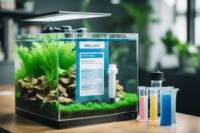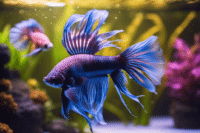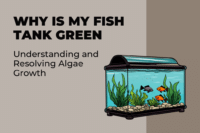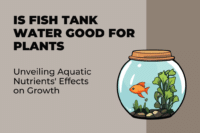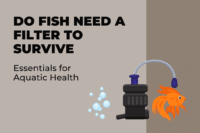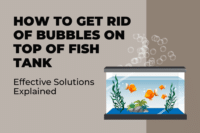Is granite safe for your fish tank? Short answer: yes, granite can be a safe and durable choice for your aquarium. Adding granite not only enhances the natural beauty of your aquascape but also provides a stable environment for your fish.
To use granite, make sure it’s cleaned properly and tested before placing it in your tank. Ensure there is no excessive fizzing when soaked in water as that can indicate it’s unsuitable. Think about its weight too; granite rocks can be heavy and might put stress on the glass walls if not placed carefully.
Incorporating granite into your aquascape can turn your fish tank into a stunning underwater landscape. Just take the necessary precautions and you’ll have a beautiful, safe habitat for your aquatic friends.
Key Takeaways
- Granite is safe and enhances the tank’s natural beauty.
- Proper cleaning and testing of granite are essential.
- Be mindful of granite’s weight to avoid stressing the tank’s glass.
Why Granite Might Rock Your Aquarium
Granite can be a fantastic addition to your fish tank due to its durability and aesthetic appeal. However, its use comes with some important considerations to keep your aquatic pets safe and happy.
Advantages of Using Granite
Granite is a durable and inert stone, making it a great choice for aquarium decor. Its inert nature means it won’t alter your water quality, which is crucial for fish health. Unlike other rocks, granite does not leach minerals that could change the pH levels in your tank.
Besides being safe, granite’s unique appearance can make your aquarium stand out. Uniform pieces of granite can create a sleek and natural look, providing caves and resting spots for your fish. Its weight helps it stay in place, ensuring stability for the structures you build.
Potential Risks and Considerations
Weight is a key consideration when using granite in an aquarium. Heavy granite can pressure the tank glass, potentially causing scratches or cracks. Always add a buffer layer of sand or gravel before placing granite to minimize this risk.
Another consideration is granite’s sharp edges, which might injure fish. Smooth any sharp bits before adding the granite to the tank. Each piece of granite may have a different mineral composition, so test for safety by soaking it in water and checking for fizzing.
Regularly clean and check the granite for contaminants to ensure it remains safe for fish health. If you notice any changes in your fish’s behavior or water quality, it’s best to re-evaluate the use of granite in your tank.
Selecting the Best Rocks for Your Tank
Choosing the right rocks for your fish tank is crucial for maintaining water quality and ensuring the safety of your aquatic life. Let’s dive into the safe options and those you should avoid, as well as how these rocks can impact water chemistry.
Safe Rocks and Those to Avoid
Safe Rocks:
- Quartz: An excellent choice for its inert properties.
- Slate: Does not alter water parameters and provides a natural look.
- Lava Rocks: Lightweight and safe for all types of tanks.
- River Rocks: Smooth and aesthetically pleasing.
Rocks to Avoid:
- Limestone: Can increase water pH and hardness, harmful to some fish species.
- Calcite: Similar to limestone, it can alter water chemistry.
- Marble: Also impacts pH and hardness negatively.
- Sandstone: May contain impurities or dissolve over time.
The Impact of Rocks on Water Chemistry
Different rocks can affect your tank’s water chemistry in various ways.
Water pH and Hardness:
- Limestone and marble can significantly raise water pH and hardness due to their calcium content.
- Sandstone might break down and release unwanted minerals into the water.
Safe Choices:
- Quartz, slate, and lava rocks are neutral, maintaining stable water parameters.
- River rocks are generally inert but always test them first.
Testing Rocks:
Always test rocks by soaking them in water and checking for any changes in pH or hardness. If you see excessive fizzing, it’s a sign the rock may not be safe for your aquarium.
Preparing Rocks for Your Aquarium
Getting your rocks ready for an aquarium is crucial for your fish’s health and your tank’s aesthetics. You’ll need to clean and sterilize the rocks and arrange them nicely in your tank without harming aquatic life.
Cleaning and Sterilizing Process
First, choose smooth rocks to avoid scratching your fish. Sharp rocks can be harmful. You can test the compatibility of your rocks using the vinegar test. Pour a few drops of vinegar on the rock. If it fizzes, avoid using it as it may alter the water chemistry.
Next, clean the rocks. Place them in a large bucket and scrub them with a brush to remove dirt and contaminants. Avoid using soap or chemicals as they can be toxic to fish. Instead, rinse the rocks thoroughly with tap water.
For sterilization, boil the rocks for at least 10 minutes to kill any bacteria. Alternatively, you can soak them in a bleach solution and then rinse them thoroughly. Make sure no bleach remains by soaking the rocks in fresh water until any bleach smell is gone.
Positioning and Aquascaping Techniques
Position the rocks carefully in your tank. Start by placing larger rocks at the bottom to create a stable base. This prevents them from toppling over. Use gravel to fill gaps and stabilize the structure.
Aquascaping is the art of arranging rocks, gravel, and plant life to create a natural environment. Create hiding spots and territories for your fish by strategically placing rocks. Aim for a natural look by mixing different sizes and shapes.
Think about the composition of your tank. Balance the arrangement to avoid an overcrowded look. Use stands or supports if needed to secure heavier rocks, ensuring they don’t press against the tank walls.
Maintaining an Aquarium with Granite
Keeping your aquarium healthy and vibrant involves some specific tasks. Granite, being safe and inert, adds a natural charm. But maintaining this setup requires careful attention to water quality and routine cleaning.
Routine Maintenance Tips
Regular maintenance is key to a thriving fish tank. Start by cleaning the granite thoroughly before placing it in the tank to remove any dust or debris. This prevents contamination and ensures water quality.
Weekly water changes are essential. Replace 10-20% of the water to dilute any waste products and keep the environment healthy for your fish. Use a gravel vacuum to clean up any waste that settles on or around the granite pieces.
Don’t forget to scrub the granite periodically. Algae can build up on the rocks, making the tank look dirty and potentially affecting water chemistry. Use a soft-bristled brush to gently scrub away any algae without damaging the granite.
Monitor the tank’s debris levels. Excess waste can lead to poor water quality. Make sure to remove uneaten food and plant debris regularly.
Monitoring Water Parameters
Maintaining proper water parameters is crucial. Granite is inert, meaning it doesn’t significantly alter water pH or hardness. But you still need to keep an eye on the water conditions.
Use a water testing kit to check parameters like pH, ammonia, nitrite, and nitrate levels. Test weekly to ensure your tank remains stable.
For freshwater tanks, aim for a pH between 6.5 and 7.5, while saltwater setups should be around 7.8 to 8.4. Ensure ammonia and nitrite levels are at zero, as these can be toxic to your aquatic pets.
Beneficial bacteria play a huge role in breaking down waste products. Make sure your tank is cycled properly and monitor bacterial colonies. If levels drop, consider adding bacteria supplements to boost the ecosystem.
Watch for any signs of stress in your fish, such as unusual behavior or discoloration. This can often indicate water quality issues that need addressing immediately.
Important Points to Remember:
- Clean the granite: Ensure it’s free from contaminants.
- Placement: Put sand or fine gravel first to avoid scratching the tank.
- Inspect rocks: Check for sharp edges to protect your fish.



